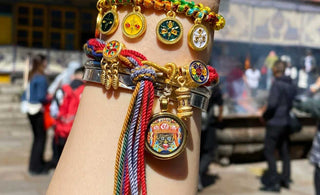
Introduction:
Nestled in the heart of Tibetan culture are treasures that transcend time—antique beaded accessories that weave a tapestry of tradition, craftsmanship, and spirituality. Among these, the allure of Tibetan beaded accessories stands out as a testament to a rich cultural heritage. From prayer beads to intricately crafted pieces, these artifacts not only adorn the wearer but also carry profound symbolism and historical significance. In this exploration, we delve into the world of Antique Tibetan Beaded Accessories, unraveling their cultural context, craftsmanship, symbolic meanings, contemporary relevance, and the art of preservation.
1. Cultural Context:
Tibetan beaded accessories are steeped in the cultural richness of the region, each bead telling a story of centuries-old traditions. From prayer beads used in religious ceremonies to ornaments worn in daily life, these accessories serve as tangible expressions of Tibetan identity. The choice of materials, colors, and patterns reflects the symbiosis between nature, spirituality, and the daily lives of the people. Understanding the cultural context is essential to appreciating the intricate beauty and significance embedded in each bead.
Turquoise, revered for centuries, holds a prominent place in Tibetan culture. It's not merely a gemstone but a revered symbol of protection, spiritual well-being, and a connection to the divine. Within the context of Tibetan beaded accessories, the use of turquoise isn't arbitrary; each bead or stone carries inherent spiritual significance. Often associated with the patron saint, this gemstone is believed to safeguard wearers from negative energies and adversity.
2. Craftsmanship and Artistry:
The craftsmanship behind Tibetan beaded accessories is a form of art that has been refined through generations. Skilled artisans employ traditional techniques, often passed down within families, to create intricate patterns and designs. From the vibrant prayer beads to the meticulously carved dzi beads, the level of detail reflects a dedication to preserving ancient crafting methods. Exploring the techniques employed provides insights into the meticulous process of transforming raw materials into timeless adornments.
Advancements in technology also aid in preservation endeavors. Digital archiving, 3D scanning, and high-resolution imaging techniques contribute to creating comprehensive records of these artifacts. These digital archives not only serve as references for restoration but also enable wider accessibility for research and educational purposes
3. Symbolic Meanings:
Beyond their aesthetic appeal, Tibetan beaded accessories carry profound symbolic meanings. Prayer beads, for instance, serve as a tangible aid in meditation and religious practices. Dzi beads, with their unique patterns, are believed to possess protective and auspicious qualities. Each symbol etched into the beads tells a story—of spirituality, protection, and the interconnectedness of life. Unraveling these symbols unveils the layers of wisdom and beliefs woven into the very fabric of Tibetan culture.
4. Contemporary Relevance:
While rooted in tradition, Tibetan beaded accessories continue to find relevance in the contemporary world. Modern designers and wearers alike are drawn to the timeless beauty and spiritual significance of these artifacts. The adaptability of Tibetan bead designs to contemporary fashion showcases the enduring appeal of these accessories. Exploring how these traditional treasures resonate with the present sheds light on their ability to transcend cultural and temporal boundaries.
5. The Art of Preservation:
Preserving the legacy of antique Tibetan beaded accessories is an ongoing challenge and responsibility. The materials used, such as coral, turquoise, and amber, require delicate care to ensure longevity. Additionally, the knowledge of traditional crafting techniques must be safeguarded and passed on to future generations. Examining efforts in preservation, from museum collections to community initiatives, unveils the steps taken to protect these cultural treasures for posterity.
Preserving artifacts containing turquoise, coral, and amber demands specialized care due to the unique properties of these materials. Turquoise, for instance, is sensitive to chemicals and extreme temperatures, requiring gentle cleaning methods and controlled storage conditions to prevent discoloration or degradation. Coral and amber, being organic materials, also demand careful handling to maintain their luster and structural integrity.
Museum collections play a crucial role in safeguarding these treasures. Climate-controlled environments, expert curation, and conservation efforts ensure the longevity of these artifacts. Conservationists employ advanced techniques to stabilize, clean, and protect the materials, ensuring they retain their original charm for generations to come.
Community initiatives, too, contribute significantly to preservation. These initiatives focus on education, passing down traditional crafting techniques, and raising awareness about the historical and cultural value of these accessories. By engaging local artisans and communities, these initiatives help sustain the legacy of craftsmanship while instilling a sense of pride and responsibility in preserving their heritage.
Conclusion:
Preserving the legacy of antique Tibetan beaded accessories, especially those embodying the patron saint of the turquoise clavicle chain, demands a harmonious blend of traditional conservation practices and innovative approaches. Embracing these challenges ensures that these cultural treasures continue to enchant and inspire, bridging the past with the present and securing their relevance for the future.
In the intricate beads of Tibet lies a world of cultural richness, craftsmanship, symbolism, contemporary relevance, and the art of preservation. Antique Tibetan Beaded Accessories are not merely adornments; they are portals to a vibrant heritage that continues to captivate hearts and minds. As we journey through the cultural landscape of Tibet, these treasures stand as a testament to the resilience of tradition and the enduring beauty of human craftsmanship. In embracing the past, we find the threads that weave the present and illuminate the path forward, ensuring that these traditional treasures endure as timeless symbols of Tibetan culture.
























